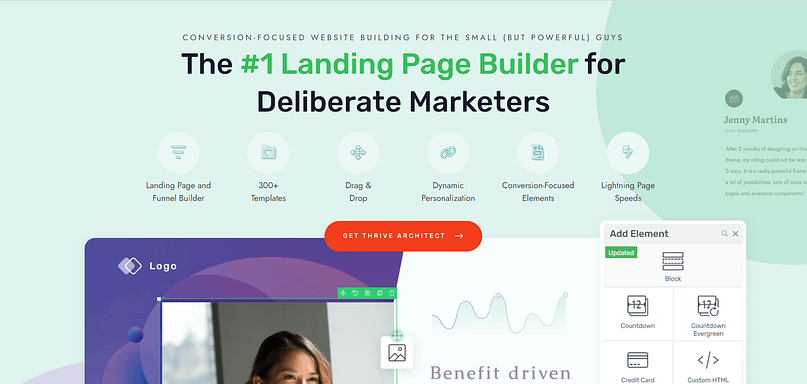I’ve seen this happen too often: great blog posts, solid keyword research, helpful products — and still… crickets.
Not because the content is bad, but because it’s scattered. Search engines can’t figure it out. Visitors get lost. Conversions stall.
The fix? SEO silos.
By grouping related content and linking it with intent, silos make your site easier to navigate, easier to rank, and far more effective at guiding readers toward the next step.
I’ve used this strategy to help businesses grow organic traffic and improve conversions — without rewriting a single post.
If you're putting in the work to create great content, this is how you make it actually pay off.
Before we dive deeper, here’s the quick version of what I’ve learned (and keep reminding myself) about silos:
- When I build silos, I’m not just grouping blog posts—I’m creating a map that tells Google, “Hey, I know this subject inside out.”
- I lean on soft silos (smart internal links) because they’re flexible and human-friendly. Rigid folder structures? That’s 2010 SEO.
- A silo isn’t finished when the content is neatly filed away. For me, the real win is when that structure moves readers closer to action—an opt-in, a product, or a booked call.
- And yes, Google agrees: internal links are “super critical” for SEO (John Mueller said it, Search Engine Journal echoed it). That’s why I treat them like VIP passes, pointing people straight to the pages that matter most.
Think of this as your compass: keep these points in mind, and the rest of the strategy will click into place.
What Are SEO Silos (and Why They Still Matter in 2025?
Don't want to read through all the theory? Skip to the step-by-step tutorial
An SEO silo is a way of organizing your website content so that related pages are grouped together, linked strategically, and focused on a single topic or theme. This makes it easier for both search engines and your visitors to understand your site and navigate through it.
The most effective (and practical) way to do this today is through internal linking. This means connecting related content so it flows naturally and helps both readers and search engines understand how everything fits together.
I came across a 2025 guide from Search Engine Land saying internal links “tell search engine bots what’s important,” helping your fresh content get visibility faster. (Search Engine Land)
Even outside expert panels, in Positional’s April 2023 piece, Nate Matherson points out that internal links do more than help rankings — they shape your site’s structure, guide visitors, and spread authority to posts you care about most.
The Modern Approach: Soft Siloing
The most practical (and effective) way to structure your site today is through soft siloing — using internal links to connect related content. This approach is flexible, easy to implement in WordPress, and doesn’t require you to restructure your entire site.
You can reinforce this structure by:
🧠 You might see examples online that recommend using strict folder-style URLs like /email-marketing/subject-lines/ (this is known as a “hard silo”). That approach still works — but you don’t need it to build an effective silo structure. What matters is how your content connects, not how your URLs look.
This kind of structure helps Google crawl your site more efficiently, understand your content hierarchy, and recognize your authority on specific topics. But just as importantly, it helps your visitors stay engaged — because they can easily find what they’re looking for, and what comes next.
What’s the Difference Between Silos, Content Hubs, and Topic Clusters?
Let’s be honest: the jargon can get messy. Silos, clusters, hubs — they sound similar, but the way you use them shapes both your SEO and your user experience.
This table breaks down the differences between silos, clusters, and content hubs for you:
Type | How It's Structured | How It Links | Best For | Example |
|---|---|---|---|---|
SEO Silos | Content is sorted into clearly defined topics (like categories) | Mostly links within its own topic | Building focused authority on a few distinct areas | A nutrition site with separate silos for “Keto,” “Vegan,” and “Intermittent Fasting” |
Topic Clusters | One broad topic with a main guide + several supporting articles | Links between the main post and all related ones | Covering a single topic in depth across multiple angles | A “Complete Guide to Freelancing” linked to posts on pricing, client management, taxes, and tools |
Content Hubs | One central page that links to a variety of posts (often evergreen) | Can link in/out, across topics or categories | Creating a beginner-friendly portal or a resource library | A "Start Here" page on a site for online entrepreneurs with tools, tutorials, and templates |
My take? Go hybrid. Build silos deep enough to show authority, but flexible enough to cross-link where it genuinely helps the reader journey. Semrush has argued that rigid silos feel outdated in a modern search environment, and I couldn’t agree more.
Choosing Your Silo Structure: Hard vs. Soft
I get asked a lot: “Do I need to change my URLs to build silos?” The short answer is no — and here’s why.
Why Silos Still Work — Even as Google Gets Smarter
Some people think you don’t need to worry about structure anymore because search engines can “figure it out.” That’s only partly true.
Google is more advanced now, but it still relies on clear signals to understand what your site is about — and how everything connects.
A well-structured site is one of the best ways to provide them.
A good silo structure helps with that. Here’s how:
But Aren’t SEO Silos Outdated?
There’s been some pushback on siloing in recent years, especially the rigid, old-school version where content was locked into isolated buckets with no cross-links.
That’s not what we’re talking about here.
Modern siloing is about clarity, not confinement.
You can (and should) link across silos if it makes sense for the reader — just do it intentionally.
You’re creating content journeys that help people go deeper into a topic and move toward the next logical step.It’s not about building walls. It’s about building structure.
✅ The goal isn’t isolation — it’s momentum.
✅ The goal isn’t just SEO — it’s conversions.
And that’s why SEO silos, when done right, still matter — and still work.
❗Rigid, no-cross-link silos can feel artificial and even hurt UX if you overdo it. Semrush points out that this kind of confinement can limit both authority flow and user satisfaction . A smarter approach is link-led: keep the topical clarity of a silo, but allow contextual cross-links when they improve the journey. That way you get the best of both worlds — authority and usability.
The Right Tools Make All the Difference
You can have the perfect silo strategy mapped out, but if your website is hard to navigate, visually cluttered, or missing clear calls to action, it won’t perform the way it should.
How you present your content matters just as much as how you structure it.
That’s why I always recommend using tools that make it easy to organize your content, guide your visitors, and connect everything clearly — especially if you’re building with WordPress.
For me, that tool is Thrive Architect.
It’s what I use to build pillar pages, create SEO-friendly posts, add in-content CTAs, highlight related posts, and make sure everything looks clean, intentional, and conversion-ready.
It saves time, and more importantly, it lets you design content that actually drives action.
A good setup should let you:
Design clear, conversion-focused pages
Surface related content in a way that makes sense to both humans and search engines
If you’re serious about making your content perform — not just exist — then the tools you choose matter more than you think. I put together a breakdown of the SEO content optimization tools I personally use to plan, improve, and rank content faster (without bloating my tech stack).
👉 Check out the tools I rely on to optimize every blog postThe Modern Silo Strategy: Balanced, Contextual, and Conversion-Focused
SEO silos work best when they do more than organize your content — they should guide your visitors through a natural journey that builds momentum and leads to action.
People don’t browse your site in straight lines. They explore, they jump between ideas, and they follow what feels relevant.
That’s why your silo structure should focus on flow — not just hierarchy.
Ask yourself:
- How do visitors move from one piece of content to the next?
- Where do they get stuck or drop off?
- What’s the natural next step after reading this post?
🔍 Pro tip: If you’re not sure how people are navigating your site, tools like MonsterInsights can help you visualize user journeys, track engagement, and identify which pages are doing the heavy lifting — and which ones need a boost.
Here’s what a modern, conversion-focused silo looks like:
✅ Content is grouped by topic — but not boxed in
🔗 Internal links are added with purpose, connecting related ideas
🎯 Every silo supports a business goal: growing your list, selling a product, or booking a call
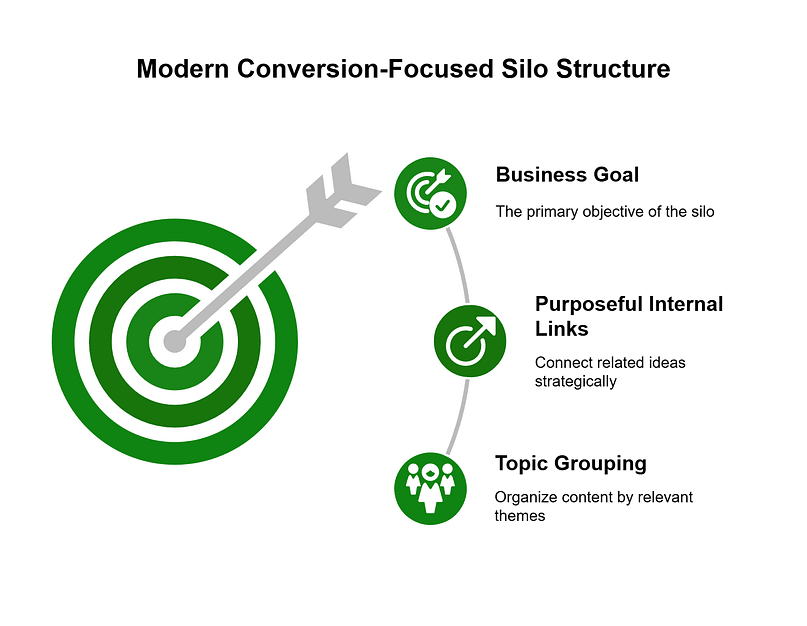
👇 Example: A Silo That Converts
Let’s say your site teaches people how to sell online courses. One silo could focus on email marketing.
You’d have:
A WordPress page that introduces the topic and links to deeper subtopics (we call this a pillar page)
Supporting content, organized like a grid or content hub, like:
How to write better subject lines
What to include in your course launch sequence
Opt-in ideas for course creators
Email automation tips
Each post links back to the pillar, and also to other posts in the silo when it adds value — like linking from subject lines to launch sequences.
The result? A content experience that’s easy to follow, builds topical authority, and creates more opportunities to convert.
🧠 Want to build out this kind of structure? Here’s how to create a content hub that works in 2025 →
Structure Meets Strategy
If your content is well-organized but doesn’t lead anywhere, it’s just a blog archive.
But when each post nudges the reader toward a useful next step — a lead magnet, a signup, or a product — you’re turning content into a system. A good way to do this is to think of your blog as a funnel.
And the right tools can make that structure easier to build and maintain.
🛠 With Thrive Architect, you can:
Highlight related content using styled content boxes
Add in-line CTAs that don’t interrupt the flow
Build clear, well-designed pillar pages that tie everything together
When your content structure supports your conversion goals, every page starts working harder.
How to Build SEO Silos That Actually Work (and Convert)
If you’re working with WordPress and already publishing content regularly, you don’t need to start from scratch. You just need a smart structure that organizes what you have — and gives every new piece of content a clear place to live and a purpose.
Here’s how to do that, step by step:
Step 1: Define Your Core Topics (Silo Themes)
Start with your content pillars — the main topics your audience cares about and that support your business goals.
Ask yourself:
What do I want to be known for?
What content do I already have (or plan to create)?
What should this content lead to — an offer, a lead magnet, a product?
Take the Thrive Themes blog, for example. We have hundreds of posts, and we definitely can’t leave those unorganized.
So we created four silos based on our ultimate business goals — and to help readers quickly find content that speaks to what they’re building:
Build Your Website | Build Your Business | Build Your Mailing List | Build Your Funnels
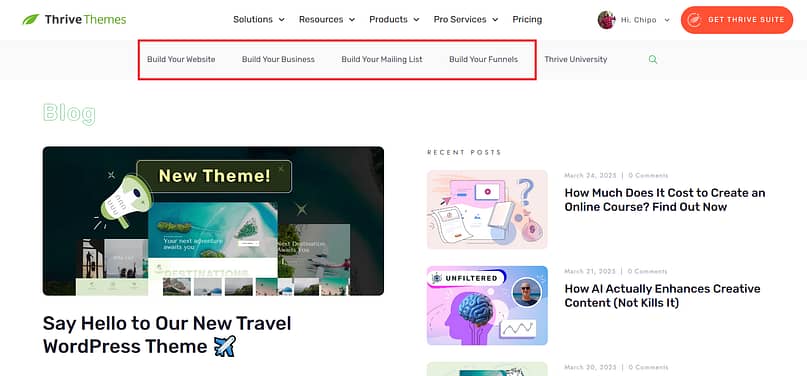
Each of those categories acts as a silo: grouping content, guiding the journey, and naturally leading into the next step — whether that’s reading another post, signing up, or checking out a tool.
Before you lock them in, use keyword research to validate and refine each theme with keyword research and intent data, then map a primary conversion for that silo (whether that’s a lead magnet, a product, or a booking). That’s what makes this more than “neat filing.”
Step 2: Build Your Pillar Pages (Silo Heads)
Each silo needs a central page — a pillar page — that introduces the topic and connects all the related content within that silo.
This page acts as the anchor. It gives readers an overview, helps them find what they’re looking for, and sets the stage for the journey ahead.
Your pillar page should:
Give a clear summary of the topic
Link to all supporting content in that silo
Include CTAs that match the reader’s intent — like a lead magnet, product, or next step
Be designed to guide, not overwhelm
Take a look at one of the pillar pages on Ali Abdaal’s (a 6-figure earning course creator and productivity expert) website.
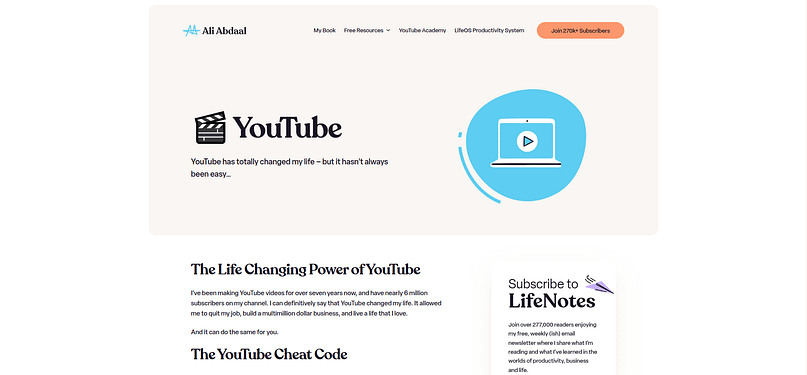
It introduces the core topic, links to related videos and blog posts, and guides the visitor through a natural learning journey — all while staying visually clean and easy to navigate.
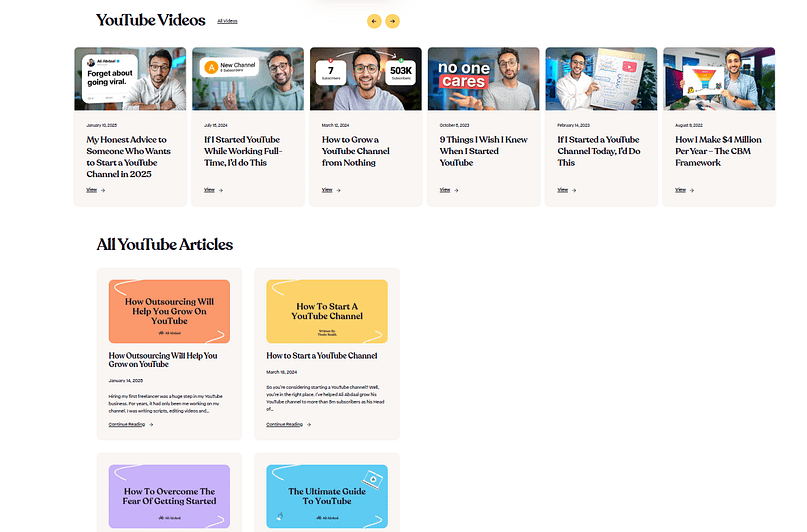
🛠 If you’re using Thrive Architect you can easily create your pillar pages too, it’s easy to add content blocks, highlight related resources, and place CTAs exactly where they make the most sense — without relying on a developer.
👉 I like to add a “Latest in this Topic” dynamic post list so the page updates itself, and a primary CTA block (built in Thrive Architect) that matches what the reader is searching for.
Step 3: Create and Organize Supporting Content
Supporting content dives deeper into the subtopics covered in your silo. These are often the posts that pull in search traffic — and they’re what help build out your topical authority.
Each post should:
Link back to the pillar page
Link across to other supporting posts in the same silo (when it makes sense)
Lead readers toward a small win — like downloading a resource, subscribing, or taking action
✏️ If you're starting from scratch, think in “question clusters.” What does your audience want to know within this topic?
🔗 If you're working with existing content, use an internal linking audit to identify and fix broken or missing links. Tools like All in One SEO make this easier with their built-in Link Assistant, which helps you spot internal linking opportunities across your site without manually digging through every post.
Take a look at how Monday.com’s “Product Development Life Cycle” page handles supporting content. The pillar page introduces the core topic and then displays related posts covering Agile methodologies, Kanban, Scrum, and other relevant subtopics.
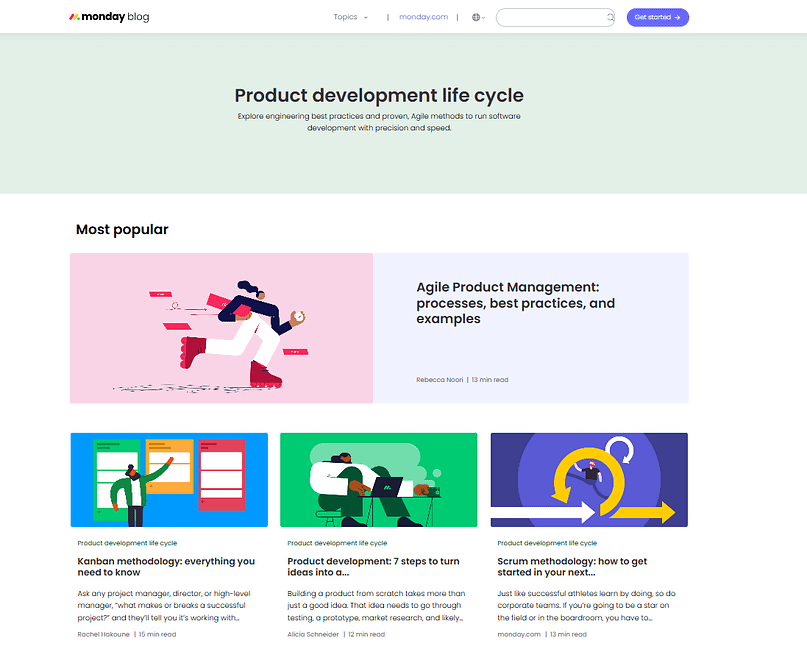
The content is neatly organized in a grid layout that makes it easy for readers to explore related topics — a strategy that improves both user experience and SEO.
If you’re using Thrive Architect, you can choose from pre-designed content blocks that make it easy to showcase supporting content in a clean, consistent layout.
You can also mix and match elements like:
- Accordions (great for FAQs or grouped posts)
- Post lists filtered by category or tag
- Columns or tabs to break content into stages or themes
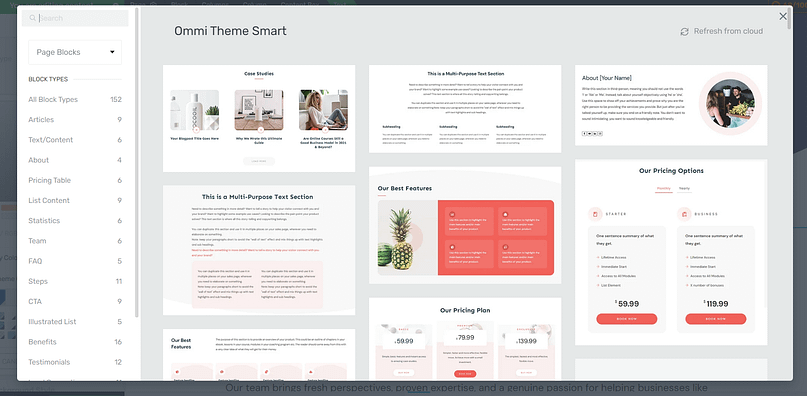
The goal isn’t just to organize your posts — it’s to guide the reader through your silo in a way that makes sense and encourages them to keep exploring.
Step 4: Plan Smart Internal Linking (Soft Siloing)
This is where your silo structure really starts to work.
Internal links are what connect your content — guiding both readers and search engines through a topic in a way that feels intentional and helpful.
Make sure every supporting post links clearly back to the pillar page and to each other where relevant (but don’t force it).
You can also reinforce your silo using:
- Breadcrumbs to show users where they are in the content hierarchy
- Navigation menus (dropdown or mega menus) that surface top-level topics
- Related content boxes, which you can easily add using Thrive Architect
🔗 Thrive Architect gives you multiple ways to handle this — from inserting a simple text link or button to using styled “related posts” blocks that match your silo theme and keep readers engaged.
And if you look carefully, you’ll see I’ve deployed that strategy throughout this article.
"Do I need to change my URLs to use silos?"
Not at all. Focus on internal links, content structure, and user experience. That’s what really makes silos effective — not your URL format.
Keeping It Working: How to Maintain and Scale Your SEO Silos
SEO silos aren’t a one-and-done setup. As your site grows, so does your content — and if you don’t revisit your structure regularly, it’s easy for things to get messy behind the scenes.
Here’s how to make sure your silos keep performing and evolving as your business does.
Audit Your Silos Regularly
At least once a quarter, check in on your silo structure. Things shift over time — and if you’re not watching, your content can drift out of alignment.
Look at:
- Which content belongs where
- Which pages aren’t linked properly
- Which silos are overstuffed — or too shallow
You don’t need anything fancy. A simple doc or spreadsheet that tracks your pillar pages, supporting posts, key internal links, and CTAs (or conversion paths).
Tools to make this easier:
- Use All in One SEO’s Search Statistics to quickly see which pages are performing, which ones are declining, and where your opportunities are.
- Use TruSEO inside AIOSEO to optimize your content for on-page SEO best practices.
- Run top-performing posts through SEOBoost to ensure your content structure, headers, and keyword usage are competitive with what's ranking.
Keep Pillar Pages Fresh
Your pillar pages should evolve over time. As you add new content:
- Add it to your pillar page
- Update the layout to reflect new subtopics (e.g. use jump links or content blocks)
- Keep CTAs relevant to your current offers
✅ Automate Content Updates Where Possible
One of the best ways to keep your pillar pages fresh without constant manual updates is to use dynamic post lists or content grids that automatically pull in the latest supporting content.
And if you're using Thrive Architect, you won’t have to worry about this — our post lists update automatically as new content is published (unless you manually program them not to).
This approach keeps your pillar pages relevant and aligned with your growing content — without adding extra work to your plate.
Refresh Supporting Content Too
Supporting posts are where most traffic lands — so don’t let them go stale.
Revisit them to:
- Update internal links to newer or more relevant posts
- Embed new lead magnets or offers
- Add CTAs that reflect your current funnel or audience needs
This is especially important if you’ve changed your product lineup, updated your brand voice, or refined your audience targeting.
Track What’s Working (and What’s Not)
You can’t improve what you’re not measuring.
Pay attention to silo-level performance:
- Organic traffic to each content group
- Time on page, bounce rate, and scroll depth
- Conversions: signups, clicks, or purchases
Tools like Google Analytics, Google Search Console, and MonsterInsights, can help you spot what’s working — and where to double down.
🎯 Remember: the goal isn’t just traffic. It’s traffic that turns into action
Ready to Make Your Silos Convert Even Better?
A great silo structure gets people to the right content — but it’s your calls to action that move them forward.
If you’ve built out your silos and want to make sure they actually lead to clicks, signups, or sales…
👉 Check out my guide on how to improve CTA click-through rates →
It covers what makes a CTA stand out, where to place them, and how to design them for higher conversions — whether you're using Thrive Architect or just getting started with your content strategy.
A Few SEO Silo Mistakes to Avoid
Setting up SEO silos seems simple at first, but I’ve learned it’s surprisingly easy to fall into a few common traps.
One I see often is creating too many silos with too little content. It makes your site feel thin — to both visitors and search engines. It’s better to start with a few strong silos that align with your main offers, then build depth over time.
Another easy mistake? Linking only to the pillar page and forgetting about the rest. Each post should be part of a network, guiding readers through your content naturally. And while we’re here: skip the overuse of exact-match anchor text — keep your links natural and helpful.
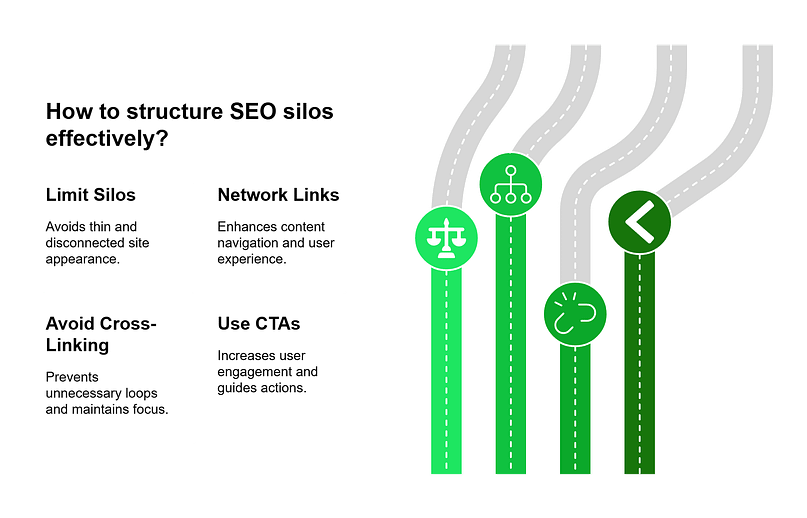
It’s also tempting to cross-link between silos just to “spread link juice.” But I’ve found that links should always enhance the reader’s journey, not distract from it.
And finally, don’t overlook CTAs. A well-structured silo is great — but it should also guide your reader to take the next step, whether that’s downloading a lead magnet, exploring a product, or signing up for your list.
Final Thoughts: Why SEO Silos Are About More Than Just SEO
Structuring your content into SEO silos isn’t just about rankings — it’s about building a site that makes sense to your audience, to search engines, and to your business.
When your content is organized with purpose:
Visitors find what they need faster
Google better understands your site
You build momentum, trust, and authority
And most importantly — you create clear paths to conversion
SEO silos give your content strategy structure that scales. They turn disconnected blog posts into a system — and your website into an experience that drives results.
Want to bring that structure to life without wrestling with your theme or plugins? I use Thrive Architect to build pillar pages, organize content visually, and guide readers through a journey — strategically and without code.
👉 Try Thrive Architect and start turning your content into a conversion-focused experience →


